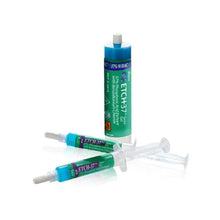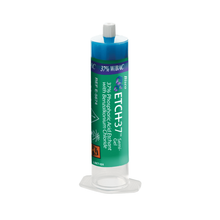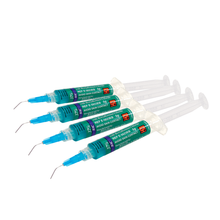Etch-37™ with BAC
37% Phosphoric Acid Etchant with Benzalkonium Chloride
Etch-37 is a 37% semi-gel phosphoric acid etchant available with Benzalkonium Chloride (BAC) and designed for etching tooth structure prior to bonding. Bisco etchants are the only dental etchants with BAC!
Curion is the ONLY authorized distributor of BISCO products in Canada. This product is backed by the manufacturer's warranty.


Etch-37 w/BAC is a 37% phosphoric acid semi-gel etchant that is effective at quickly etching enamel and dentin. Etch-37 w/BAC is polymer-thickened and effectively removes the smear layer, etches and demineralizes enamel and dentin. It is easily manipulated into small areas such as endodontically treated root canals and undercuts. This makes it more versatile than some thicker gel etchants for etching all restorative surfaces. Published research proves that BISCO etchants produce higher bond strengths to (wet or dry) dentin1 and enamel.
UNIQUE BENEFITS
- Rinses away cleanly and quickly leaving no residue to interfere with bonding
- Blue in color for easy visualization and contrast
- Creates microretentive surface characteristics that are necessary for successful bonding
- New bulk syringe delivery system available
- Contains benzalkonium chloride (BAC), an antimicrobial agent. In-vitro research shows it is effective against Actinomyces viscosus2
NOTE: Inclusion of BAC has not been shown to correlate with a reduction in secondary decay in patients. In-vivo clinical studies to evaluate the effects of BAC on oral bacteria or caries have not been performed.
1. Kanca, J.J. “Etchant composition and bond strength to dentin”. Am J Dent 1993;6:162-164
2. Dr. Daniel Chan, University of Texas Health Science Center at San Antonio Dental School. Residual Effect of 1 and 2% Benzalkonium Chloride Incorporated into an Etchant on the Susceptibility of Actinomyces viscosus T14V. 1993
Frequently Asked Questions
BISCO Etchant was made into a semi-gel form using a polymer thickening agent rather than conventional submicron silica etching gels. Conventional silica etching gels have been shown to leave submicron silica debris, following rinsing, on the etched surface.
Benzalkonium chloride (BAC) is an antimicrobial agent. When BAC is present, research confirms the development of residual bacterial inhibition zones of up to 7mm, making it effective against Streptococcus mutans.1,2
1. M.Sc.Dt. Emre ÖZEL, Dr. Haktan YURDAGÜVEN, Yrd.Doç.Dr. Esra CAN SAY, Prof.Dr. Sesin KOCAGÖZ, Evaluation of the Antibacterial Activity of Disinfectant Solutions with Phosphoric Acids Against Streptococcus Mutans. Journal of Hacettepe Faculty of Dentistry, Volume: 29, Issue 4, Page: 8-14, 2005
2. M. TURKUN1, Z. ERGUCU, L.S. TURKUN, E.U. CELIK, and M. ATES, Is Phosphoric Acid Sufficiently Antibacterial?,J Dent Res 85 (Spec Iss B):abstract number 1605, 2006 (www.dental research.org).
The term "total-etch" is used for simultaneous etching of enamel and dentin with phosphoric acid to remove the smear layer and to obtain micro-porosities for the integration of the bonding agent. The etching should start with enamel and then move to dentin. BISCO recommends a 15 second etch as a general guideline. Excessive etching of dentin may cause hypersensitivity and incomplete hybrid layers.
It is critical to keep the prepared dentin moist. Wet (moist) bonding is desirable because it prevents exposed collagen fibers from collapsing. For total hybridization and optimal bond strength, these exposed collagen fibers must be infiltrated and saturated by the primer/adhesive. The saturation is confirmed clinically by observing a glossy surface of primer/adhesive after thorough evaporation of the solvent. Over dried collagen leads to the formation of a dense amorphous layer that may impede infiltration of the primer/adhesive solution into the intertubular dentin and results in incomplete hybridization.
Air drying is not recommended. Air drying may collapse collagen fibrils while incorporating air into the dentinal tubules with possible cause of postoperative sensitivity. High volume suction removes pooled water and allows for collagen fibrils to remain sufficiently hydrated, facilitating primer infiltration. Alternatively, an absorbent pellet may be used to blot pooled water from the dentin.















































